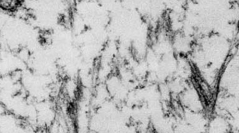

 Comptes Rendus Palevol
3 (6-7) - Pages 591-604
Comptes Rendus Palevol
3 (6-7) - Pages 591-604After a synthesis on some recent data on the biology of bone tissues senso lato, this paper focuses on the limits of known variability of bone regarding its amount of mineralisation (maximal and minimal) and on the underlying control mechanisms. Two models of hypermineralised bones are reviewed among cetaceans: the rostrum of the ‘beaked whale’ Mesoplodon and the tympanic bulla of the dolphin Delphinus. In the first case, hypermineralisation is reached lately through an ultrastructural specialization of the secondary osteons. In the second case, hypermineralisation starts at once, during foetal life, through a specialization of the primary osteons. In both cases, ultrastructural peculiarities of collagen fibrillogenesis are demonstrated. Diameter and spacing of the fibrils leave an exceptional empty space available for mineral deposition. Conversely, hypomineralisation is observed on the model of the Teleost scale. The basal plate of the scale is made of a regular ‘biological plywood’ of densely packed collageneous fibres. The mineral is laid down mostly in the interfibrillary spaces. All such tissue modulations seem to be rigorously controlled by details of the osteoblast biosynthetic activities. In a given situation, osteoblasts may express only a subset of molecules from their potential complete biosynthetic repertoire. The debate now centres on how osteoblasts acquire positional information to express this subset.
Collagen, bone, hypermineralisation, hypomineralisation, osteoblast